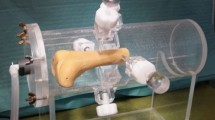Abstract
Introduction: The assessment of fracture healing is subjective, and neither radiology nor manual examination allows a reliable determination of bone healing. Fracture healing control in the treatment of tibia shaft fracture with external fixator by a stiffness measurement system (Fraktometer FM 100®) is known from clinical studies. The purpose of this study was to follow stiffness control at external fixator in healing of callotasis with the stiffness measurement system. Materials and methods: From 1994 to 1997 stiffness measurements with the described system (Fraktometer FM 100) were performed in the BG-Clinic Ludwigshafen to assess the healing course in 11 cases of callotasis at lower limb. Results: In ten cases, regular healing could be followed by signal decrease; in one case, a persistent signal without tendency to decrease was able to reveal callotasis failure at an early point of time. The investigation could also show the importance of bending stiffness control. One case of late axis deformation after fixator removal occurred because of disregarding delayed bending signal decrease. Conclusion: Measurements of the external fixator’s stiffness after callotasis can provide useful additional information for further treatment strategy.






Similar content being viewed by others
References
Benirschke SK, Mirels SH, Tencer AF (1993) The use of resonant frequency measurement for the noninvasive assessment of mechanical stiffness of the healing tibia. J Orthop Trauma 7:64–71
Claes L (1991) Die Messung der Knochenheilung bei Fixateur-externe Osteosynthesen mit dem Fraktometer FM-100. Chirurg 62:354–355
Claes L, Grass R, Schmickal T, Wentzensen A (2002) Monitoring and healing analysis of 100 tibial shaft fractures. Langenbecks Arch Surg 387:146–152
Dwyer JSM, Owen PJ, Evans GA, Kuiper JH, Richardson JB (1996) Stiffness measurements to assess healing during leg lengthening. J. Bone Joint Surg 78-B:286–289
Eastaugh-Waring SJ, Hardy JR, Cunningham JL (2000) Fracture stiffness measurement using the orthometer: reproducibility and sources of error. Clin Biomech 15(2):140–142
Eyres KS, Bell MJ, Kanis JA (1993) New bone formation during leg lengthening: evaluated by dual-energy X-ray absorptiometry during limb lengthening. J Bone Joint Surg (Br) 75-B:96–106
Fellinger M, Schanzer A, Szyszkowitz R, Leitgeb N, Stockenhuber N, Roupec R (1993) Computerisierte Sonometrie—die Anwendung eines nichtinvasiven Verfahrens zur Stabilitätsbeurteilung nach Frakturen. Akt Traumatol 23:235–238
Kisse B, Eggers C (1995) Können Zeitpunkt und Indikation zur sekundären Knochentransplantation bei verzögerter Knochenbruchheilung unter Fixateur-externe-Behandlung durch Fraktometermessung bestimmt werden? In: Wolter D, Hansis M, Havemann D (eds) Externe und interne Fixationssysteme. Springer, Berlin Heidelberg New York, pp 112–114
Raschke MJ, Claudi BF (1998) Monorail-Methode: Segmenttransport und Verlängerung. In: Rüter A, Kohn D, Correll J, Brutscher R (eds) Kallusdistraktion. Urban & Schwarzenberg, München Wien Baltimore, pp 79–90
Richardson JB, Cunninghamm JL, Goodship AE, O‘Connor BT (1994) Measuring stiffness can define healing of tibial shaft fractures. J Bone Joint Surg [Br] 76:389–394
Richardson JB, O’Connor BT (1993) Direct fracture stiffness measurement in tibial fractures. Int J Orthop Trauma 3:72–74
Schmickal T, Wentzensen A (1996) Die Fraktometermessung zur Beurteilung des Neokallus. Swiss Surg (Suppl) 2:13
Schmickal T, Winkler H, Wentzensen A (1996) Fraktometermessung zur Beurteilung der Stabilität des Neokallus. Hefte zur Unfallheilkunde 262:158
Stürmer KM, Rack T (1990) Intravitale Bewegungsmessungen bei der Frakturheilung. Hefte Unfallheilkunde 212:489–498
Tower SS, Beals RK, Duwelius PJ (1993) Resonant frequency analysis of the tibia as a measure of fracture healing. J Orthop Trauma 7:552–557
Wentzensen A (1995) In-vivo-Messung der Knochenheilung bei Fixateur externe-Osteosynthesen. In: Wolter D, Hansis M, Havemann D (eds) Externe und interne Fixationssysteme. Springer, Berlin Heidelberg New York, pp 107–111
Author information
Authors and Affiliations
Corresponding author
Rights and permissions
About this article
Cite this article
Schmickal, T., Recum, J.v. & Wentzensen, A. Stiffness measurement of the neocallus with the Fraktometer FM 100® . Arch Orthop Trauma Surg 125, 653–659 (2005). https://doi.org/10.1007/s00402-005-0049-6
Received:
Published:
Issue Date:
DOI: https://doi.org/10.1007/s00402-005-0049-6




